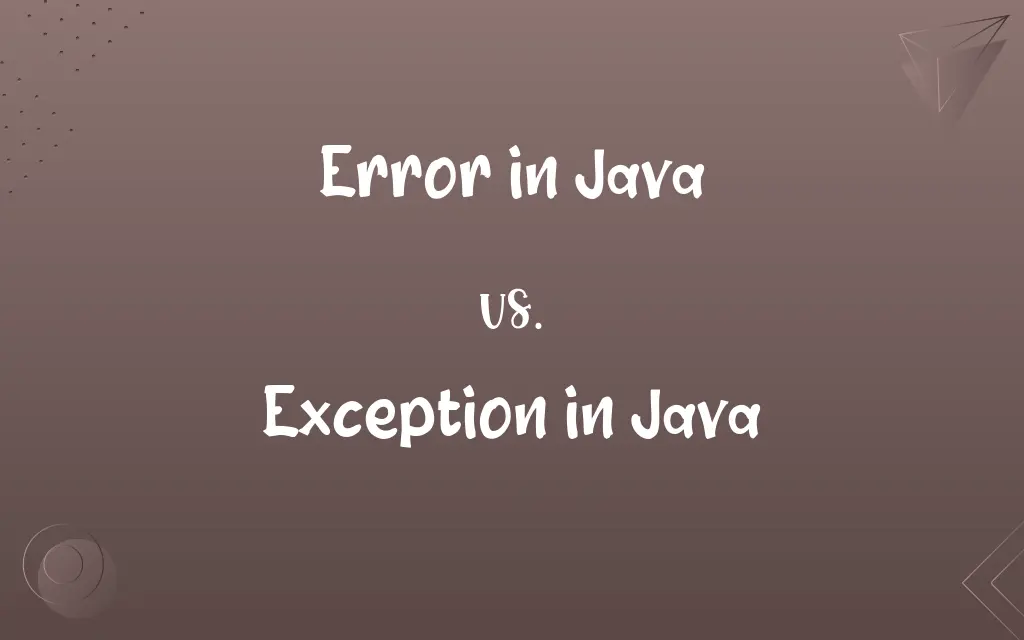Error in Java vs. Exception in Java: Know the Difference

By Shumaila Saeed || Published on February 4, 2024
In Java, an Error indicates a serious problem that a reasonable application should not try to catch, while an Exception suggests conditions that a reasonable application might want to catch.

Key Differences
Error in Java refers to a serious problem that arises during the runtime environment and is not intended to be caught or handled by the program. It often signals a problem that the program cannot recover from, like system failures. Exception in Java is a condition that occurs during the execution of a program and disrupts the normal flow of instructions. Exceptions are events that a program can try to catch and handle to prevent the program from terminating abruptly.
Shumaila Saeed
Feb 04, 2024
Error in Java is usually linked with the environment in which the application is running. These are abnormal conditions beyond the control of the program, such as hardware failure or a system crash. Exception in Java, on the other hand, often results from the program itself and can include scenarios like invalid user input, or file not found situations. Exceptions are typically divided into checked exceptions, which must be handled in the code, and unchecked exceptions, which are not required to be handled.
Shumaila Saeed
Feb 04, 2024
In Java, Error is a subclass of the Throwable class, but it is different from RuntimeException and Exception. It is designed for situations that are not meant to be caught by applications. For instance, OutOfMemoryError occurs when the JVM runs out of memory. Exception, conversely, is also a subclass of Throwable but is intended to be caught and handled in the application. It represents problems that the application should anticipate and recover from, such as FileNotFoundException.
Shumaila Saeed
Feb 04, 2024
Error in Java is indicative of serious problems that a typical Java application should not try to catch, as it is often impractical or impossible to recover from them. For example, StackOverflowError occurs when a stack overflow occurs because of excessive deep or infinite recursion. Exception in Java suggests that the application might want to handle the condition, either to recover from it or to perform some sensible cleanup, before terminating. For instance, a SQLException indicates problems with database connectivity or queries.
Shumaila Saeed
Feb 04, 2024
When dealing with Error in Java, it’s generally advised to let the program terminate, as these errors are often critical and beyond the application’s ability to handle. Exception in Java, however, encourages a more graceful handling of issues, often using try-catch blocks to manage and respond to different problems, allowing the program to continue running or terminate more gracefully.
Shumaila Saeed
Feb 04, 2024
ADVERTISEMENT
Comparison Chart
Nature
Indicative of serious system problems
Represents conditions that can be handled
Shumaila Saeed
Feb 04, 2024
Common Causes
System failures, hardware issues
Programming errors, external conditions
Shumaila Saeed
Feb 04, 2024
ADVERTISEMENT
Error in Java and Exception in Java Definitions
Error in Java
An Error in Java is a serious problem that arises from the system, not the application.
OutOfMemoryError occurs when the JVM runs out of heap space.
Shumaila Saeed
Jan 24, 2024
Exception in Java
An Exception in Java is a condition that disrupts the program's normal flow.
FileNotFoundException is thrown when a file is not found.
Shumaila Saeed
Jan 24, 2024
Error in Java
In Java, Error indicates severe failures related to the runtime environment.
InternalError indicates an unexpected internal error in the Java Virtual Machine.
Shumaila Saeed
Jan 24, 2024
Exception in Java
Exception in Java can be either checked or unchecked.
IOException must be either caught or declared in the method signature.
Shumaila Saeed
Jan 24, 2024
Error in Java
Error represents irrecoverable conditions, often external to the application.
NoClassDefFoundError is thrown when a class is present at compile time but missing at runtime.
Shumaila Saeed
Jan 24, 2024
ADVERTISEMENT
Exception in Java
Exception indicates conditions that a reasonable application might want to catch.
ArithmeticException occurs and can be caught when dividing by zero.
Shumaila Saeed
Jan 24, 2024
Error in Java
Error in Java reflects issues beyond the programmer's control.
LinkageError occurs when a class has some dependency issues with another class.
Shumaila Saeed
Jan 24, 2024
Exception in Java
Exception represents manageable issues often caused by the program itself.
NullPointerException is thrown when calling a method on a null object reference.
Shumaila Saeed
Jan 24, 2024
Error in Java
Error in Java signifies problems that applications should not try to catch.
StackOverflowError happens with excessive recursion.
Shumaila Saeed
Jan 24, 2024
Exception in Java
In Java, Exception is meant to be caught and handled in the application.
SQLException is handled to maintain database integrity after a failed transaction.
Shumaila Saeed
Jan 24, 2024
Repeatedly Asked Queries
What is an Exception in Java?
An Exception is a condition that can disrupt the program’s flow but can be caught and handled.
Shumaila Saeed
Feb 04, 2024
What is an Error in Java?
An Error indicates a serious issue, typically external to the application, like hardware failure.
Shumaila Saeed
Feb 04, 2024
Can you catch an Error in Java?
While it's possible, it’s not recommended as Errors are serious issues beyond typical application scope.
Shumaila Saeed
Feb 04, 2024
Can Errors be prevented in Java?
Errors, being system-level issues, are generally not preventable by the application.
Shumaila Saeed
Feb 04, 2024
How does a try-catch block work with Exceptions?
Try-catch blocks capture Exceptions, allowing the program to handle them and continue running.
Shumaila Saeed
Feb 04, 2024
Are Exceptions in Java recoverable?
Yes, Exceptions are often recoverable through proper handling using try-catch blocks.
Shumaila Saeed
Feb 04, 2024
Is OutOfMemoryError an Exception?
No, OutOfMemoryError is an Error indicating that the JVM has run out of memory.
Shumaila Saeed
Feb 04, 2024
What is a common cause of a NullPointerException?
Calling a method on a null object reference causes a NullPointerException.
Shumaila Saeed
Feb 04, 2024
What causes a StackOverflowError?
StackOverflowError typically occurs from uncontrolled recursion depth.
Shumaila Saeed
Feb 04, 2024
How do checked and unchecked Exceptions differ?
Checked Exceptions must be declared or handled, while unchecked Exceptions don’t have this requirement.
Shumaila Saeed
Feb 04, 2024
Can you give an example of an unchecked Exception?
ArithmeticException is an unchecked Exception, occurring, for instance, on dividing by zero.
Shumaila Saeed
Feb 04, 2024
How do you handle a checked Exception?
By either using a try-catch block or declaring it in the method signature with 'throws'.
Shumaila Saeed
Feb 04, 2024
Can IOException be ignored in Java?
No, IOException is a checked Exception and must be handled or declared.
Shumaila Saeed
Feb 04, 2024
What indicates a problem like a missing file in Java?
FileNotFoundException, an Exception, indicates a missing file scenario.
Shumaila Saeed
Feb 04, 2024
What kind of problems do Errors represent?
Errors represent severe problems, often related to the system or runtime environment.
Shumaila Saeed
Feb 04, 2024
Is it good practice to catch Throwable?
Generally not, as it catches both Errors and Exceptions, which are handled differently.
Shumaila Saeed
Feb 04, 2024
What’s the difference between Error and RuntimeException?
RuntimeException is an unchecked Exception, while Error is a serious problem beyond application control.
Shumaila Saeed
Feb 04, 2024
How does an application typically respond to an Error?
Applications often cannot do much about an Error and might terminate.
Shumaila Saeed
Feb 04, 2024
Is a memory leak an Error or an Exception?
Memory leaks are typically not categorized as either but are a result of poor memory management in the application.
Shumaila Saeed
Feb 04, 2024
Is an Error a subclass of Exception?
No, both Error and Exception are subclasses of Throwable, but Error is not a subclass of Exception.
Shumaila Saeed
Feb 04, 2024
Share this page
Link for your blog / website
HTML
Link to share via messenger
About Author
Written by
Shumaila SaeedShumaila Saeed, an expert content creator with 6 years of experience, specializes in distilling complex topics into easily digestible comparisons, shining a light on the nuances that both inform and educate readers with clarity and accuracy.




































































